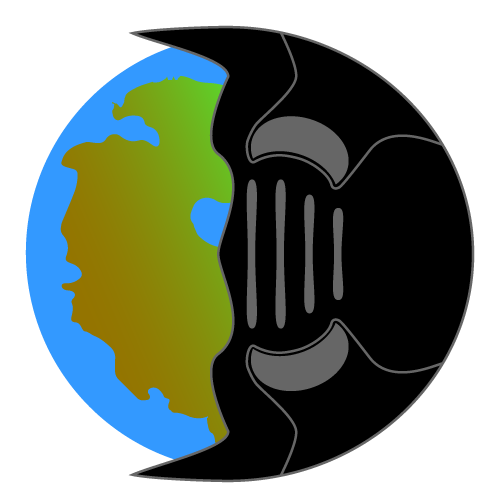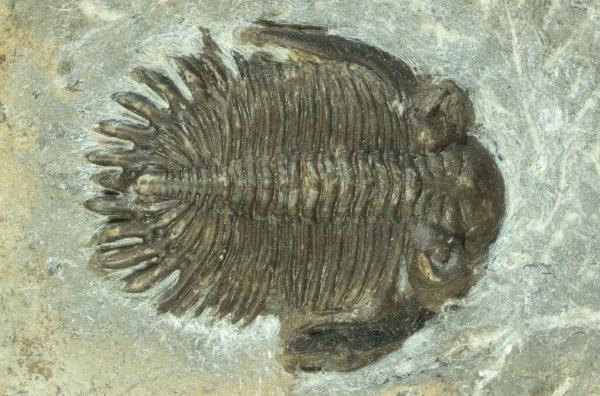Scientific Classification
| Kingdom: Animalia |
| Phylum: Arthropoda |
| Class: Trilobita |
| Order: Phacopida |
| Family: Acastidae |
| Genus: Bellacartwrightia |
| Species: Bellacartwrightia jennyae Lieberman and Kloc, 1997 |
Information
Geological Range
Paleogeographic Distribution
Stratigraphic Occurrences
| Ludlowville Formation |
| Centerfield Limestone |
| Onondaga Limestone |
References
Lieberman and Kloc (1997): Evolutionary and biogeographic patterns in the Asteropyginae (Trilobita, Devinian) Delo, 1935. in Bulletin of the American Museum of Natural History. American Museum of Natural History, pp. 31-43.
Bignon and Cronier (2014): The systematics and phylogeny of the Devonian subfamily Asteropyginae (Trilobita: Phacopida). Journal of Systematic Palaeontology 12: pp. 637-668.
Remarks
From Wilson (2014, p. 204): “Pygidial lappets smooth and triangular in cross section; 14 pygidial axial rings. To 40mm.”
Description: From Lieberman and Kloc (1997): “Cephalic length (sag.) 55% of width. Axial furrow nearly straight anterior to SO, diverging forward at about 250, narrow, shallow. Cranidial anterior border developed as moderate lip deflected moderately anterior to facial suture. Preglabellar furrow shallow and narrow. Cranidial anterior border of constant length (sag.) from lateral to medial edges of frontal lobe. Facial suture anterior to eyes flexes laterally then medially, with smoothly convex margin laterally. Posterior branch of facial suture flexes weakly anteriorly, then posteriorly laterally. Glabellar length equal to width across frontal lobe; frontal lobe ellipsoidal, about 65% of length of glabella; frontal lobe at level of posterior glabellar region; anterior part of frontal lobe moderately declined forward, faintly pointed in dorsal view. PMI shallow linear incision. S3 shallow, weakly sinusoidal, equally incised medially and distally, branches diverging at about 1400. Sagittal region of L3-L2 nearly flat (tr.), lateral lobes weakly declined abaxially. L3 wedge shaped, bearing isolated tubercles, lengthening distally, outer edge forming smaller angle with sagittal line at anterior end than at posterior end. S2 weakly declined posteriorly at lateral edge, moderately incised, shallow adjacent to axial furrow. S 1 deep, crescent shaped, medial part developed as smooth curve convex posteriorly, laterally contacting axial furrow. Li short, flexed forward strongly medially and weakly abaxially, depressed only slightly below L2 laterally. SO of nearly uniform length, convex anteriorly medially in dorsal view, deep. LO 55% of width of frontal lobe, moderately arched (tr.), longest sagittally, bearing spine on medial portion. Large Eye Index 0.55. Anterior edge of eye contacts axial furrow opposite anterodistal corner of L3; posterior edge of eye opposite SO, posterior to transverse line tangent to LO; eye raised prominently above frontal lobe; maximum of 10 lenses per dorsoventral file on visual surface. Fixigena evenly sloping from axial furrow to palpebrum. Postocular fixigenal field 15% of length of eye. Librigenal field moderately declined to lateral border furrow. Posterior border furrow nearly transverse, weakly flexing anteriorly distally, anterior margin nearly straight. Genal spine developed as very long flange extending back to eighth thoracic segment, cephalic border furrow bisects spine; lateral and medial edges of genal spine evenly inclined; medial edge of genal spine significantly thickened and swollen relative to lateral edge, deflected more strongly laterally posteriorly; lateral margin of genal spine parallels sagittal line; lateral margin of genal spine at posterior end recurves; interior margin of genal spine deflected laterally. Raised ridge on dorsal surface of genal spine at juncture of posterior border furrow and lateral border furrow forms sharp, doglegged kink. Lateral border furrow narrow, shallow, lateral border weakly widens posteriorly. Anterior margin of cephalic doublure bluntly pointed. Prosopon of fine tubercles. Hypostome parabolic, width (tr.) at midlength about 110% of sagittal length. Course of anterior margin (hypostomal suture) weakly convex, with moderate wings positioned far forward. Lateral margin tapering behind anterior wings at approximately 300 angle relative to sagittal line. Middle body bean shaped in outline, broadest anterior to midlength, anterior margin poorly defined; anterolateral margins defined by smooth break in slope, grading down to rather flattened anterior wing. Convexity (tr.) of middle border moderate sagittally; faintly convex (sag.) anterior and posterior lobes separated at about 65% of length by broad, shallow middle furrow. Maculae small, low, circular swellings, positioned back about 55% of sagittal length of hypostome on middle furrow, displaced medially relative to lateral border furrow 25% of width of hypostome at midlength. Posterolateral-posterior border furrows narrow, shallow. Posterolateral border of constant length (exsag., sag.), 10% of length (sag.) of hypostome. Posterior margin rounded, apparently lacking spines. Thorax of 11 segments. Axial ring about 25% of width of thorax, of equal length (exsag., sag.), at distal ends and medially flexed forward. Ring furrow of equal length (exsag., sag.), moderately incised, flexing forward medially and distally. Anterior margin of ring well defined sagittally, inclined posterodorsally, most elevated near posterior edge; scattered tubercles around medial part of axial ring, centered around medially placed, enlarged spine; single circular fenestra flanks each side of medial spine; at lateral margin of axial rings, circular fenestrae present. Articulating half ring set slightly below axial ring. Proximal part of pleura transverse, approximately horizontal; anterior segments rather evenly convex (tr.), outer part of pleurae more strongly flexed downward, straight in posterior segments. Posterior band long (exsag.), anterior margin straight, deflected at constant, small angle posteriorly; length (exsag.) shortens as length of pleural furrow increases medially, after approximate midpoint, length of pleural furrow decreases laterally, length of posterior band increases, becomes planar; posterior surface declined posterodorsally, has one transverse row of circular fenestrae near axis; anterior surface declined anterodorsally, with concave depression. Anterior pleural band short (exsag.), medially anterior margin transverse; deflecting strongly posteriorly past approximate midpoint, at roughly same level as posterior band, pinching out distally, with one transverse row of circular fenestrae. Pygidium broadly triangular in outline excluding marginal lappets, length (sag.) about 65% of width (tr.) without lappets, with five pairs of pleural lappets. Axial furrows shallow, narrow, converging at 20 degree angle anterior to sixth pygidial axial ring, roughly parallel posterior to sixth pygidial axial ring. Axis 30% of pygidial width anteriorly, with 14 rings; rings of nearly equal length distally (exsag.) and medially (sag.), bearing medial spine; anterior and posterior edge of axial rings posterior to sixth axial ring from midline to distal edge convex, then transverse. Ring furrows moderately incised. Lateral margins of pygidial lappets curved, medial margins straight, distal tips pointed. Axial terminus triangular, does not project as far posteriorly as other lappets; postaxial region 20% of pygidial length (sag.). Pygidial pleural field flanking posterior part of pygidial axis moderately excavated; anterior band of pleural segment elevated above posterior band; tops of segments rounded; pleural furrows deeper than interpleural furrows, long (exsag.). Laterally pygidial interpleural furrows arch at same angle as medially. In medial region of adjacent pleural segments posterior region of anterior segment longer (exsag.) than anterior part of posterior segment.”
Online Resources
Paleobiology Database - Bellacartwrightia.
Media
Images


